
 |

|
| |
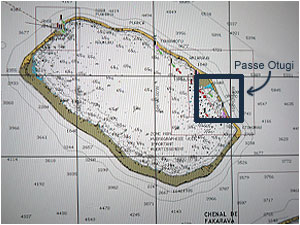
|
|
 |
Day 1,856 - Tahanea, Tuamotus (16° 58.0S 144° 35.8W)
11:25hrs - June 29th 2012
A Cautionary Tale |

It may take many years of cruising, as everyone's threshold is different, but eventually you're going to knowingly make a spectacularly bad decision, one that you would have never even considered making when you were fresh off the dock. If you're lucky it'll cost you nothing more than a bruised ego and a few extremely unpleasant moments of complete and utter disbelief as you curse your stupidity and grapple to extract yourself from whatever idiotic situation you've managed to sail yourself into. But it will be one of the most valuable lessons you will ever have, and it will help to keep you safe for many more happy years of cruising to come.
I'm talking about complacency, and it has the potential to be one of the most hazardous aspects of cruising. You can't see it, you can't predict it, and it follows you around wherever you go - whether you're on a rough passage,
a calm passage, motoring, sailing or anchored in an idyllic lagoon. It is a constant threat. But ironically the longer you cruise and the better equipped
you become to making the right decisions, the more dangerous it gets and
the more likely you are to make the wrong ones. It disguises itself behind experience and confidence, quietly accumulating until one day you reach
your limit, and find yourself doing something utterly regrettable.
I've always considered myself a relatively cautious sailor, if something doesn't feel quite right - a weather window, an approaching squall or a tight anchorage, we either remove ourselves entirely from the situation, or take steps to reduce our risk - securing ourselves, and Dream Time, so we can endure whatever's coming with a modicum of comfort and control. But it seems that over the five years we’ve been cruising and the 22,000 sea miles we've covered, Catherine and I have gradually drifted away from our rational rhumb line into increasingly dangerous waters, by embarking on passages, for example, exploring atolls and squeezing into anchorages that, a few years ago, we would have gone to great lengths to avoid.
We’ve certainly had our share of surprises on this circumnavigation, which is
to be expected: unavoidable weather systems have popped-up on passages, boat gear has failed, usually when we least want it to, uncharted bombies - narrow pinnacles of coral - have shown themselves only at the last second, and secure anchorages have suddenly transformed themselves into foam and whitewater. However, these situations are rare and are usually nothing more than a lively inconvenience, conditions that, using our experience and a little common sense, we have confidently and safely sailed ourselves away from. But recently we found ourselves doing quite the opposite and sailed into one
of the worst situations we have ever experienced. Our complacency was to blame, and it could have cost us Dream Time, or much worse.
For the last year we've been cruising in French Polynesia and for five of those months we've been happily exploring the Tuamotus or, as they was known to early mariners, 'the Dangerous Archipelagoes'. The arrangement of low-laying islands and hidden reefs, the extensive network of atolls scattered over 400,000 square miles of ocean, strong currents between atolls, and ripping tides funneling in and out of narrow passes, make the name well deserved. But over the years and with the introduction of auxiliary engines, GPS systems, leading lights, channel markers, tide tables and cruising guides, many sailors now choose to head into the Tuamotus, rather than around them. But black symbols of wrecked ships mark many reefs on the charts here, like crooked tombstones, reminding us that while beautiful, these atolls can still be unforgiving, especially if you let your guard down.
We let our guard down in the atoll of Toau, or more precisely, leaving Toau on
a day when ebbing currents ripping out of Passe Otugi were colliding head-on with strong east-southeast trade winds and heavy ocean swell - energy that rose up from a depth of over a thousand feet to under thirty in just a few boat lengths. The result was a maelstrom of powerful swirling eddies, walls of water, breakers, sudden troughs and a powerful corridor of mayhem that can, incredibly, be felt for up to two miles out to sea. And because of complacency we left right in the middle of it, at the worst possible time imaginable.
To appreciate why we made this decision, you should first understand our circumstances. For over a week we had been anchored inside the lagoon,
in the very southeastern corner, a perfectly calm and idyllic spot, and an area protected from the strong wind and seas behind a natural barrier of sandy motus and bending palm trees. And it was our fourth time in Toau in a neighborhood of the Tuamotus that we first visited in 2009, an area that feels almost as familiar to us now as the Long Island Sound back in New York.
We spent our days taking lazy walks around the uninhabited motus in search of shells, snorkeling with friendly reef fish, and when the wind was blowing twenty knots, kite surfing over a flat lagoon - chasing blacktip sharks in sandy shallows. In the evenings we’d lounge in the glow of a crackling driftwood fire on the beach, with Dream Time's anchor light, the only one in the lagoon, lost amongst the stars. We felt like we had the world to ourselves, we were relaxed, comfortable, we were at home. But familiarity fuels complacency, and just as the majority of car accidents occur in your own neighborhood, the same analogy can be used for cruisers.
We decided to depart Toau on a day we really shouldn't have. The GRIB files showed enhanced tradewinds blowing for three days before dipping south and easing to a more civilized ten to fifteen knots - a better time to transit the east-facing Passe Otugi. But with our supplies of produce running low, and with the Cobia, a supply ship that makes weekly visits to the Tuamotus from Tahiti, scheduled to deliver stockpiles of fresh fruit, vegetables and boxes of Bordeaux to Fakarava, an atoll a mere fourteen miles to the south, well, the lure was too great. And so ignoring our instincts to wait for more favorable conditions, we set-off the next morning.
The short three-mile sail from our anchorage inside the lagoon up to the pass was deceivingly pleasant, and in the lee of the islands Dream Time coasted comfortably along on flat waters under a reefed mainsail in fifteen knots of wind that spilled over the palm trees. We had convinced ourselves, prematurely, that the weather was OK, but as we cleared the last motu and approached the pass we were surprised by the conditions: wind gusting to over twenty knots, heavy ocean swell colliding with reef, and breaking seas lined-up just outside the entrance of the pass. Rather than do the prudent thing and return to our anchorage or at the very least anchor inside the pass and wait for a favorable tide, we chose to ignore our voice of reason. Complacency was in control.
As we motor sailed into the pass our speed over ground rapidly increased to nine knots, time slowed, and for five long minutes we were trapped in a roaring rip tide of churning whitewater. We met the first standing waves, one that broke over our bow while, alarmingly, another rose up and crashed over our quarterdeck and into the cockpit – we were stuck in a trough higher than our coach roof with little rudder control, beginning to broach, and it was too late to turn around. Surf broke with no order, sequence or concern. Rather than floating, it felt like Dream Time was falling from the lagoon. And it was terrifying. We do not have any photos of the conditions, but it is an experience we shall never forget. How the strong counter eddies against the tidal flow tried to drag us back towards the reef. The involuntary shaking of hands locked against the helm, the shock, fear, and utter disbelief of our decision, and the numb realization that our life jackets were still inside the lazarette.
The chaotic conditions outside Passe Otugi were without doubt the most intense and dangerous we have encountered on Dream Time. We survived without damage or injury and attribute this primarily to our strong, heavy displacement and well-maintained vessel. We made very few sensible decisions during this ordeal, but having a reefed mainsail, using the engine
to maintain speed, and keeping Dream Time on a steady heading, gave us enough stability and control to prevent her from broaching.
The next morning, anchored safely inside Fakarava with the wind blowing heavily from the southeast and still shaken from our experience the day before, our VHF received a DSC distress signal. We checked the coordinates that scrolled across our radio’s display against a chart - 15° 54.94' south / 145° 53.16' west - the vessel that required assistance was outside Passe Otugi, in exactly the position we had been caught the day before. Anxious replies were transmitted and repeated attempts were made by cruisers inside the anchorage to contact the vessel in distress, but conditions were too hazardous to venture outside, and while all radios were monitored, disturbingly nothing more was heard from the vessel.
Our experience transiting Passe Otugi was humbling, and completely unnecessary, yet we are fortunate to have had the opportunity and to learn from our ordeal without consequences. We’ve met many cruisers over the years who have shared with us experiences similar to our own and the lessons that they learned. A few, regrettably, were so traumatized that they chose to return home, and sadly one sailor, a man whom we met in the Marquesas, lost his vessel due to complacency, and very nearly his life.
Many who read this will be muttering to themselves and shaking their heads
in amazement at our obvious stupidity. And they have every right to, I would have once reacted the same way. Sadly, however, this is a lesson that often can only be truly understood by those who have confronted their own complacency. And to those who are yet unable to relate, take heed and try
not judge us too harshly, for this is a cautionary tale, but if remembered
may one day save you from making the same mistakes. |
|

|

| |
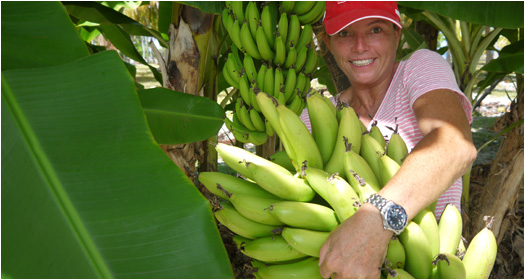
|
Quick Fix: 16° 03.91 S / 145° 37.13 W
June 21st 2012 (day 1,848)
Conditions: Wind: 12/SE Sky: Mostly Clear
Boat SPD: 0 (Anchored)

Banana Jackpot!
We are back in Fakarava for the 5th time (I know, lucky us!) so we are finally getting the hang of how things work.
Like how the supply ship, the Cobia III, usually gets here
on Thursday, and how there’s a little pension behind the school that can do laundry. But a chance meeting with Jimmy who runs an import business with his daughter Heifara, led us to one of our favorite discoveries to date, bananas! We haven’t seen bananas since we left Tahiti
in April, so meeting an importer who knows a pearl farmer who can grow bananas (very hard to do because of the coral) well what can I say, banana jackpot! - CH
|
|
|

| |
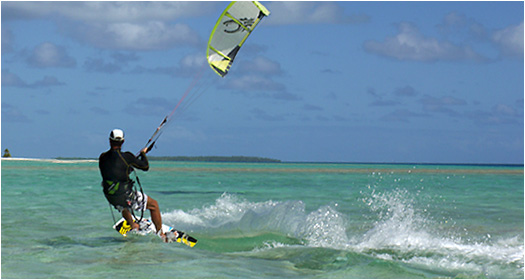
|
Quick Fix: 15° 55.94 S / 145° 53.21 W
June 17th 2012 (day 1,844)
Conditions: Wind: 18/ESE Sky: Mostly Clear
Boat SPD: 0 (Anchored)

Lone Rider
For five days we've been anchored inside an atoll - south Toau, sheltered from strong tradewinds behind a barrier
of motus and bending palms. And for the first time in a
long time, six months, Dream Time is completely
alone - our friends, fellow cruisers and kite surfing enthusiasts, have moved on, carried downwind, west
with the cruising fleet. I'm the only kite surfer here now,
but I have company - a friendly frigate bird has been flying with me, pirouetting and flirting with my kite, and in the shallows a confused black tip shark scurries and tacks under my board. But it's not the same, kite surfing alone,
but it's better than not kite surfing at all! - NH
|
|
|

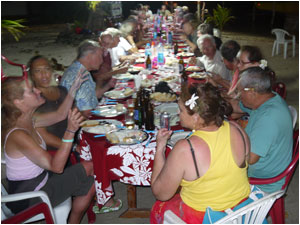
|
|
 |
Day 1,839 - Anse Amyot, Tuamotus (16° 48S 146° 09W)
17:57hrs - June 12th 2012
A Big Night on a Little Atoll |

Over the last few months we have been sailing from one quiet atoll to another and while making our way back to Fakarava one day we stopped in at Anse Amyot expecting another quiet atoll experience with nothing more taxing than an energetic fish following swim. But this little atoll had big plans.
Cruising World Magazine organizes group charters for readers who want to experience some of the far flung locations they feature in the magazine and this year one of the groups was going to sail into Anse Amyot to swim, kayak, snorkel and dive, and in the evening to come ashore for dinner. That sounds fine until you remember Anse Amyot is a tiny atoll with only 2 people living on it, and 6 catamarans and 60 people are coming for dinner! In New York, with every conceivable convenience, I would be nervous
about 60 people coming over, but on this little Pacific atoll, well it just didn't seem possible!
Gaston and Valentine whose home this is, and who are the hosts for this party were getting ready island, or should I say atoll style. They had already made long tables and rented chairs, they had rented enough tableware for 60 people, stockpiled butter flour sugar eggs etc. and fattened up pigs ready for the party in 3 days time, but there was a lot still to do, and they looked like they could do with some help.
There were 3 other cruising boats there so 8 of us got together and decided to stay and help out.
The men and women broke into two teams with the men killing pigs, chopping wood, catching fish and lobster and collecting sacks full of coconuts while the women made bread and cakes, prepared food
and the table and tidied up for the visitors. Everything was done outside, the pig killing the cake making, the fish cleaning, everything outside under whatever shade was available. Everyone had fun, our
French improved, we made new cruising friends and everyone bonded with new buddies over
our various projects.
The 6 cruising world catamarans arrived on time and our little atoll suddenly became a busy anchorage with dinghies whizzing around on their various sunny atoll adventures. By sunset with everyone full of pina coladas and stories of their days adventures, everything was ready and 60 people came ashore and sat down at a long table under the stars decorated with tropical flowers, to a flawless dinner of roast pig, barbequed fish and lobster, with coconut cake for dessert! Ta Da!!
The following evening, our last in Anse Amyot, after the Cruising World catamarans had sailed away onto their next island adventure, we joined Gaston and Valentine and the other cruisers for our own starlit dinner. It felt good to have been able to help and even though none of us had expected this little energetic interlude in our cruising journey, as Gaston and Valentine serenaded us with Polynesian songs under
the starry pacific sky we were all very happy to have had this chance to be here.
Dream Time: Changed Yanma oil (engine hours: 2,900). Changed outboard oil. Tightened inner forestay and bob stays. Sanded, compounded and waxed sheer stripe.
|

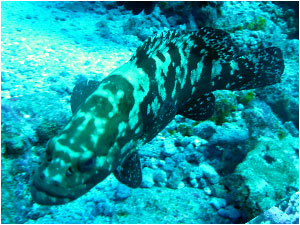
|
|
 |
Day 1,832 - Anse Amyot, Tuamotus (16° 48.18S 146° 09.17W)
16:49hrs - June 5th 2012
Fish Poisoning |

For the past two weeks cold cups of water have felt hot to touch - at times almost too hot to hold,
my legs feel like they're recovering from running a marathon, I've been exhausted, have general muscle fatigue, my stomach, well, let's just say is not operating as it should, and my feet tingle! These are all relatively mild symptoms of ciguatera - fish poisoning.
Catherine has some symptoms, too, not quite as severe as mine (or perhaps I just complain more than she does), but thankfully these symptoms are beginning to ebb, and in another week we should both be back to normal. (Although we have been given strict instructions from locals not to consume any more lagoon fish for a while.)
How did this happen? For the last two months we've been anchored in some pretty remote corners of the Tuamotus, areas where there are no villages, certainly no restaurants, supermarkets, stores or supply ships, and as we plan to remain in the Tuamotus for another year, and not wanting to go consume our precious, long-term supplies of canned foods, we've been doing a little foraging - collecting coconuts, hunting for lobster, the occasional coconut crab, and spear fishing. But it seems that one, or some, of the fish we've been dining on, have been carrying ciguatera.
Ciguatera is a natural toxin found in certain reef fish which consume dinoflagallates - a microscopic fauna found on the reef. The toxin, which does not harm the fish, accumulates in their system with age and is passed up the food chain. So it's important, when you fish around coral reefs, that you know exactly which fish are safe to consume, we thought we did and although we've been careful, ciguatera is extremely difficult to gauge (even the locals occasionally get caught out).
You see, the toxicity levels of ciguatera vary greatly between fish species, it also varies amongst the same species, and within specific areas of the lagoon, too. For example, a jack fish that is safe to consume in one area of the reef may harbor the toxin in another. And there's no sure way of knowing. Also, another reason to have you reaching for a can of Spam is that the toxin accumulates in our systems over time, and symptoms can be triggered by eating a fish with very low traces of the poisson, enough to push you over the threshold, but perhaps not others who consume the same fish.
We took precautions, but ultimately it was a marbled grouper (a fish usually safe to eat here) and our complacency, that got us - the marbled grouper was a little too big to spear and we caught it from a cluster of coral that, in retrospect, wasn't the healthiest in the lagoon.
So if you want to spear fish in the Tuamotus, shoot away, but know this:
1. First, ask locals which fish are safe to consume in the area you intend to spear.
2. Ideally only spear lagoon fish under 12" in length.
3. Only spear fish from healthy areas of the reef.
4. If you spear a fish and are unsure if it's safe, and there are no locals to ask:
a. Cook and eat a bite size piece of meat. If the fish carries ciguatera you will experience a tingling
sensation on the mouth and tongue within a few hours.
b. Locals say if rigormortus does not set-in a few hours after a fish has been killed, it's likely carrying
the toxin (I'm a little suspicious of diagnosis).
c. Ignore the testing rumors that include ants, flies, skin color, meat color and the like - they're
nonsense.
d. And if you're still not sure - don't eat it (don't even spear it).
As unpleasant as our symptoms are, we got off lightly. Scott & Wendy Bannerot, authors of The Cruiser's Handbook of Fishing, note that:
"Severe cases commence with pronounced symptoms common to mild cases, followed by various combinations of debilitating problems, including profound exhaustion, muscle pain, feelings of loose and painful teeth, visual disturbances, dilated pupils, slow reflexes, skin disorders on hand and feet, loss of hair and nails, muscular paralysis, coma, and death from respiratory paralysis. In nonfatal cases, recovery can take months, with some symptoms continuing for years." - It's enough to make you consider veganism!
Don't feel bad for us, we're now on a strict diet of fresh tuna and mahi mahi (pelagic, or ocean fish, not lagoon fish) lobster, coconuts and whatever we feel like digging out of our storage. We'll survive and,
at least for another month or so, the marbled grouper can relax, too. |

|
|








![]()